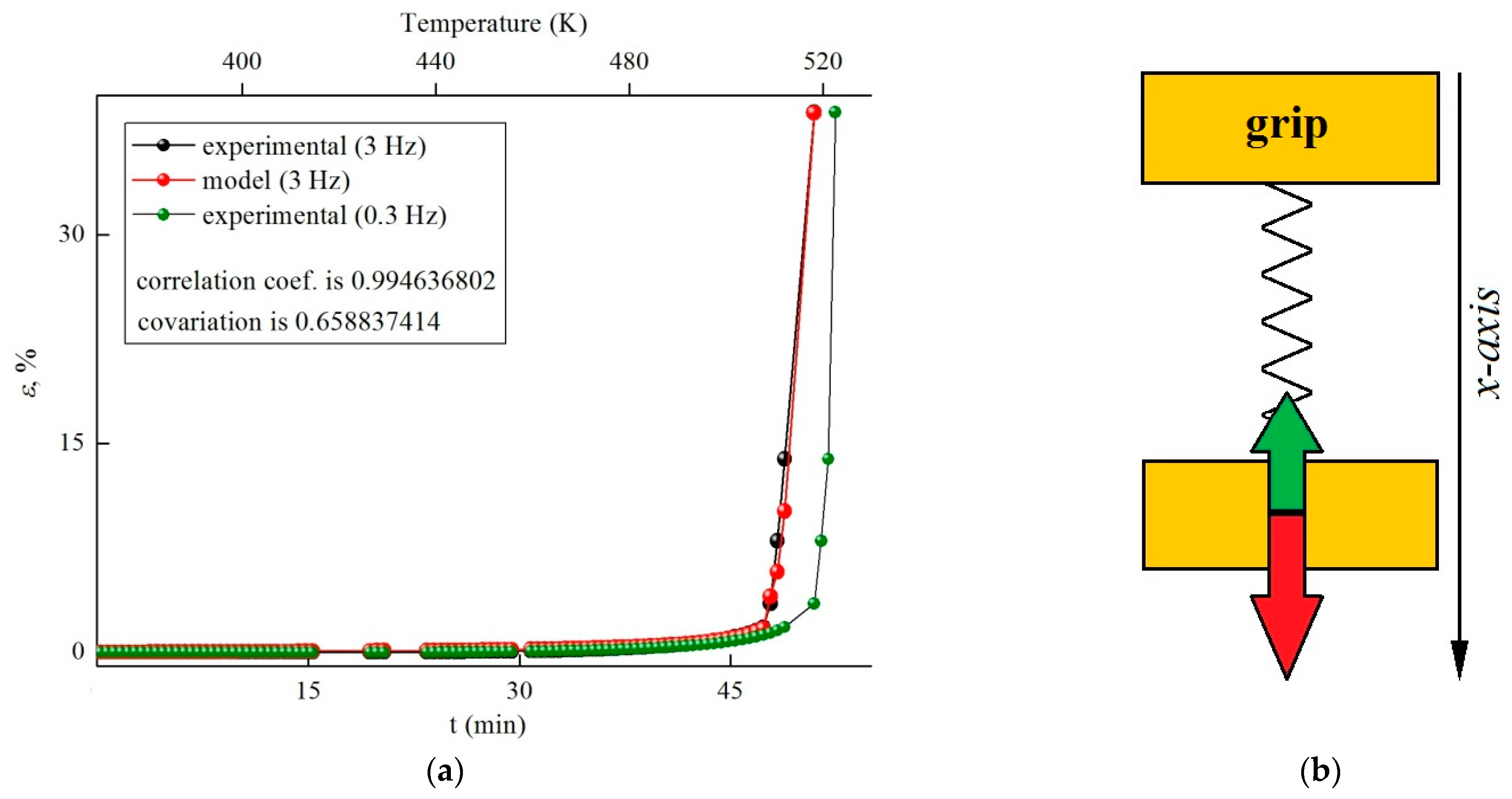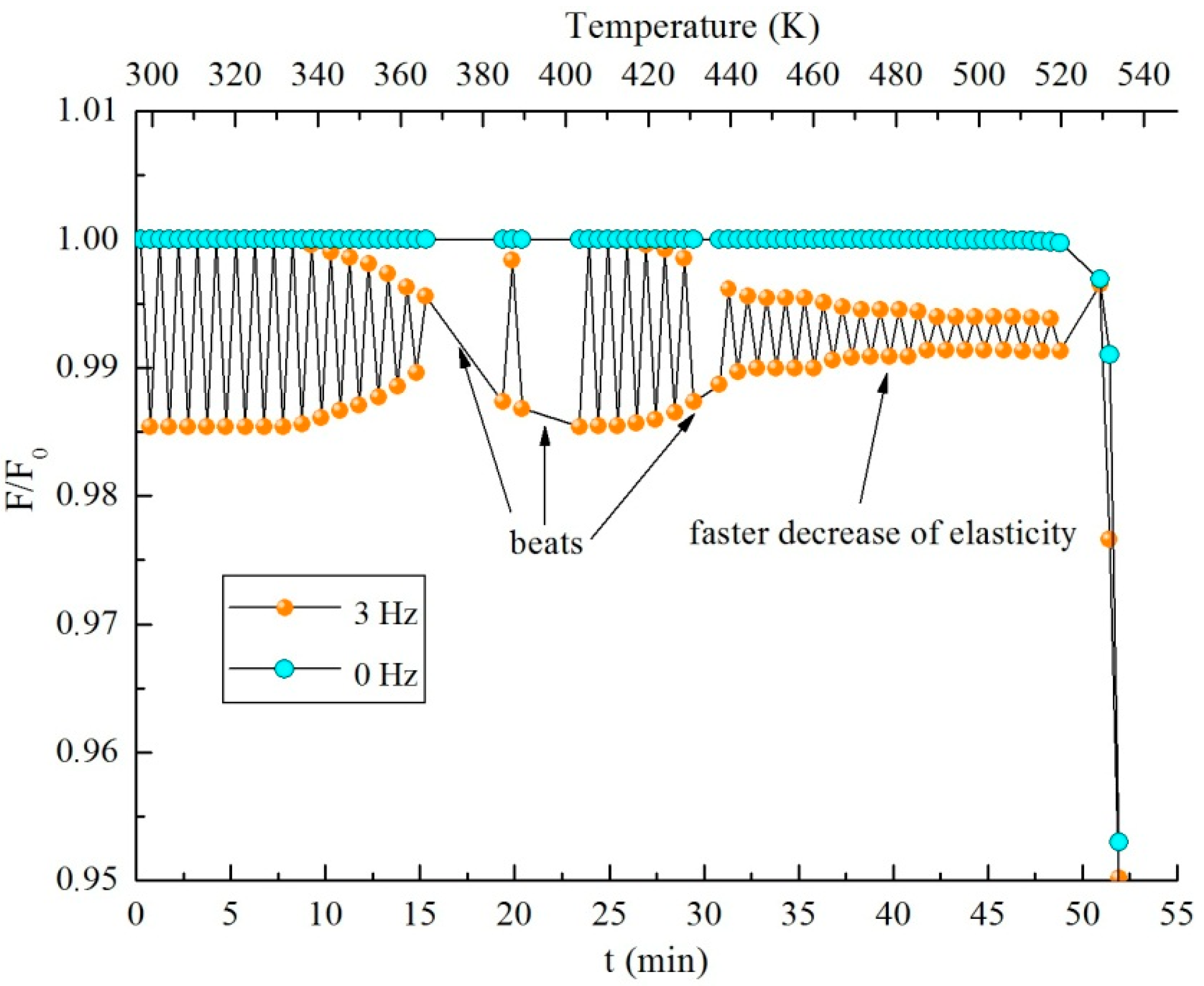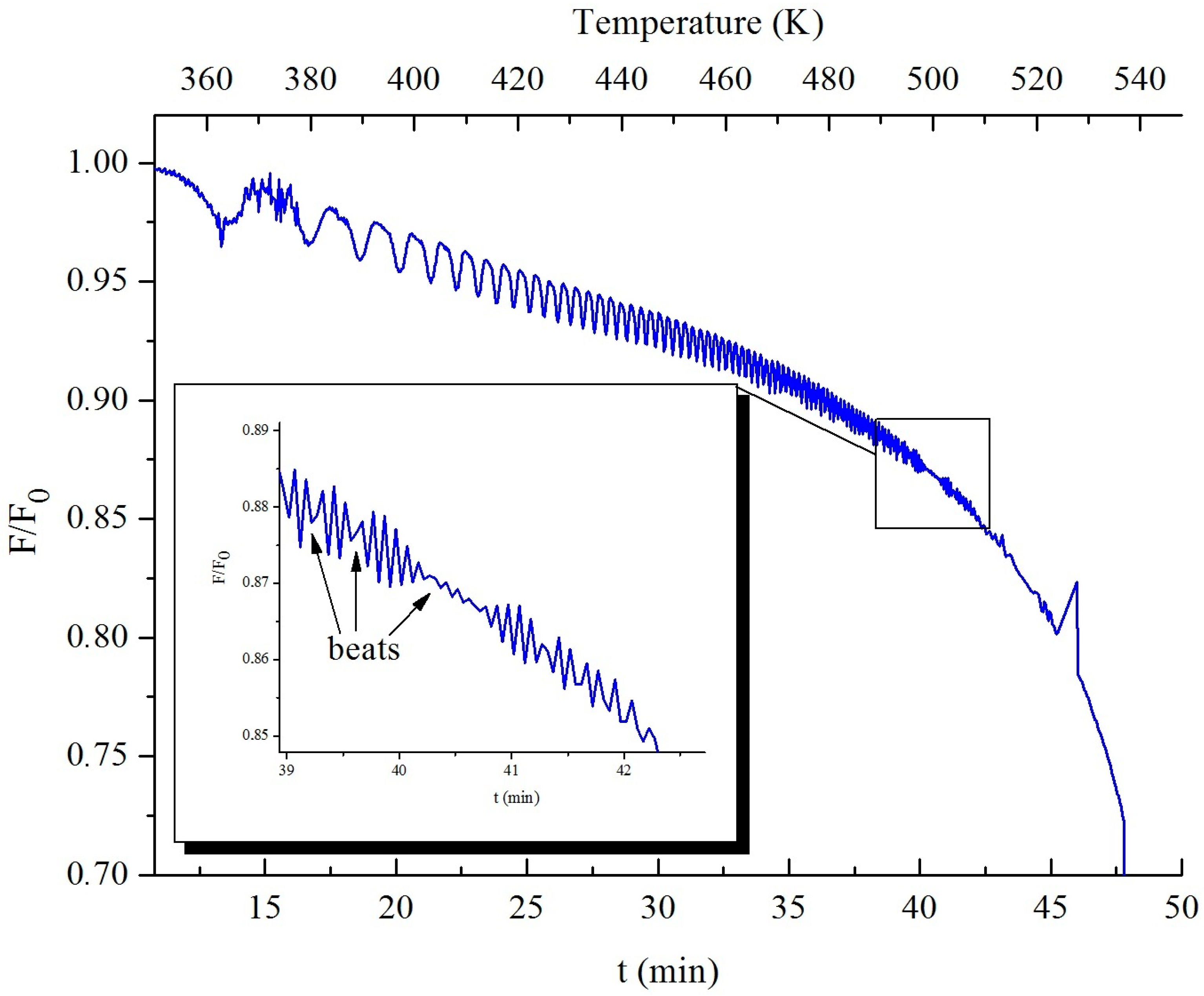Deformation of Al85Y8Ni5Co2 Metallic Glasses under Cyclic Mechanical Load and Uniform Heating
Abstract
:1. Introduction
2. Materials and Methods
3. Results and Discussion
4. Conclusions
Author Contributions
Funding
Institutional Review Board Statement
Informed Consent Statement
Conflicts of Interest
References
- Anderson, P.W. Through the Glass Lightly. Science 1995, 267, 1615–1616. [Google Scholar] [CrossRef]
- Betekhtin, V.I.; Kadomtsev, A.G.; Tolochko, O.V. Inherent submicroporosity and crystallization of amorphous alloys. Phys. Solid State 2001, 43, 1892–1897. [Google Scholar] [CrossRef]
- Louzguine, D.V.; Pol’kin, V.I. Bulk metallic glasses: Fabrication, structure, and structural changes under heating. Russ. J. Non Ferr. Met. 2016, 5, 25–32. [Google Scholar] [CrossRef] [Green Version]
- Li, N.; Ling, N.; Xu, X.; Zheng, Z.; Liu, L. Enhanced formability of a Zr-based bulk metallic glass in a supercooled liquid state by vibrational loading. Acta Mater. 2014, 65, 400–411. [Google Scholar] [CrossRef]
- Lad’yanov, V.I.; Bel’tyukov, A.L.; Men’shikova, S.G.; Maslov, V.V.; Nosenko, V.K.; Mashira, V. Viscosity of glass forming Al86Ni8(La/Ce)6, Al86Ni6Co2Gd4(Y/Tb)2 melts. Phys. Chem. Liq. 2008, 46, 71–77. [Google Scholar] [CrossRef]
- Yu, H.; Wang, W.; Samwer, K. The β relaxation in metallic glasses: An overview. Mater. Today 2013, 16, 183–191. [Google Scholar] [CrossRef]
- Duwez, P. Structure and properties of alloys rapidly quenched from the liquid state. Trans. Am. Soc. Met. 1967, 60, 607–633. [Google Scholar]
- Ketov, S.V.; Sun, Y.H.; Nachum, S.; Lu, Z.; Checchi, A.; Beraldin, A.R.; Bai, H.Y.; Wang, W.H.; Louzguine-Luzgin, D.V.; Carpenter, M.A.; et al. Rejuvenation of metallic glasses by non-affine thermal strain. Nature 2015, 524, 200–203. [Google Scholar] [CrossRef] [PubMed] [Green Version]
- Berezner, A.D.; Fedorov, V.A.; Perov, N.S.; Pluzhnikova, T.N.; Fedotov, D.Y.; Shlikova, A.A. Magnetic properties of Co-based and Fe-based tape amorphous alloys. J. Phys. Condens. Matter 2020, 32, 1–9. [Google Scholar] [CrossRef] [PubMed]
- Inoue, A. Al-Ni-Y-Co amorphous alloys with high mechanical strengths, wide supercooled liquid region and large glass-forming capacity. Mater. Trans. JIM 1990, 31, 493–500. [Google Scholar] [CrossRef] [Green Version]
- Louzguine-Luzgin, D.V.; Inoue, A. Comparative study of the effect of cold rolling on the structure of Al–RE–Ni–Co (RE = rare-earth metals) amorphous and glassy alloys. J. Non Cryst. Solids 2006, 352, 3903–3909. [Google Scholar] [CrossRef]
- Inoue, A. Amorphous, quasicrystalline and nanocrystalline alloys in Al- and Mg-based systems. In Handbook on the Physics and Chemistry of Rare Earths, 1st ed.; Gschneidner, K.A., Eyring, L., Eds.; Elsevier: North Holland, The Netherlands, 1995; Volume 24, pp. 83–219. [Google Scholar]
- Louzguine-Luzgin, D.V. Aluminum-base amorphous and nanocrystalline materials. Met. Sci Heat Treat. 2012, 53, 472–477. [Google Scholar] [CrossRef]
- Abrosimova, G.E.; Aronin, A.S. Effect of the concentration of a rare-earth component on the parameters of the nanocrystalline structure in aluminum-based alloys. Phys. Solid State 2009, 51, 1765–1771. [Google Scholar] [CrossRef]
- Abrosimova, G.E.; Aronin, A.S.; Zver’kova, I.I.; Kir’yanov, Y.V. Phase Transformations upon Crystallization of Amorphous Al–Ni–RE Alloys. Phys. Met. Metallogr. 2002, 94, 102–107. [Google Scholar]
- Wang, J.Q.; Liu, Y.H.; Imhoff, S.; Chen, N.; Louzguine-Luzgin, D.V.; Takeuchi, A.; Chen, M.W.; Kato, H.; Perepezko, J.H.; Inoue, A. Enhance the thermal stability and glass forming ability of Al-based metallic glass by Ca minor-alloying. Intermetallics 2012, 29, 35–40. [Google Scholar] [CrossRef]
- Lei, T.J.; Rangel DaCosta, L.; Liu, M.; Wang, W.H.; Sun, Y.H.; Greer, A.L.; Atzmon, M. Shear transformation zone analysis of anelastic relaxation of a metallic glass reveals distinct properties of α and β relaxations. Phys. Rev. E 2019, 100, 1–8. [Google Scholar] [CrossRef]
- Pelletier, J.-M.; Louzguine-Luzgin, D.V.; Li, S.; Inoue, A. Elastic and viscoelastic properties of glassy, quasicrystalline and crystalline phases in Zr65Cu5Ni10Al 7.5Pd 12.5alloys. Acta Mater. 2011, 59, 2797–2806. [Google Scholar] [CrossRef]
- Kumar, P.; Kumar, V.; Kumar, R.; Kumar, R.; Pruncu, C.I. Fabrication and characterization of ZrO2 incorporated SiO2–CaO–P2O5 bioactive glass scaffolds. J. Mech. Behav. Biomed. Mater. 2020, 109, 1–10. [Google Scholar] [CrossRef]
- Wang, D.P.; Qiao, J.C.; Liu, C.T. Relating structural heterogeneity to β relaxation processes in metallic glasses. Mater. Res. Lett. 2019, 7, 305–311. [Google Scholar] [CrossRef]
- Rusinko, A.; Rusinko, K. Plasticity and Creep of Metals, 1st ed.; Springer: Berlin/Heidelberg, Germany, 2011; pp. 1–442. [Google Scholar]
- Steuer, S.; Hervier, Z.; Thabart, S.; Castaing, C.; Pollock, T.M.; Cormier, J. Creep behavior under isothermal and non-isothermal conditions of AM3 single crystal superalloy for different solutioning cooling rates. Mater. Sci. Eng. A 2014, 601, 145–152. [Google Scholar] [CrossRef]
- Fedorov, V.A.; Berezner, A.D.; Beskrovnyi, A.I.; Neov, D. Determining the Form of a Hydrodynamic Flow upon Creep of an Amorphous Cobalt-Based Metal Alloy in a Variable Temperature Field. Tech. Phys. Lett. 2018, 44, 678–680. [Google Scholar] [CrossRef]
- Spaepen, F. A microscopic mechanism for steady state inhomogeneous flow in metallic glasses. Acta Metall. 1977, 25, 407–415. [Google Scholar] [CrossRef]
- Israelachvili, J.N. Intermolecular and Surface Forces, 3rd ed.; Elsevier: North Holland, The Netherlands, 2011; pp. 485–489. [Google Scholar]
- Dorrestijn, M.; Bietsch, A.; Açıkalın, T.; Raman, A.; Hegner, M.; Meyer, E.; Gerber, C. Chladni Figures Revisited Based on Nanomechanics. Phys. Rev. Lett. 2007, 98, 026102. [Google Scholar] [CrossRef] [PubMed] [Green Version]






Publisher’s Note: MDPI stays neutral with regard to jurisdictional claims in published maps and institutional affiliations. |
© 2021 by the authors. Licensee MDPI, Basel, Switzerland. This article is an open access article distributed under the terms and conditions of the Creative Commons Attribution (CC BY) license (https://creativecommons.org/licenses/by/4.0/).
Share and Cite
Berezner, A.D.; Fedorov, V.A.; Zadorozhnyy, M.Y.; Golovin, I.S.; Louzguine-Luzgin, D.V. Deformation of Al85Y8Ni5Co2 Metallic Glasses under Cyclic Mechanical Load and Uniform Heating. Metals 2021, 11, 908. https://doi.org/10.3390/met11060908
Berezner AD, Fedorov VA, Zadorozhnyy MY, Golovin IS, Louzguine-Luzgin DV. Deformation of Al85Y8Ni5Co2 Metallic Glasses under Cyclic Mechanical Load and Uniform Heating. Metals. 2021; 11(6):908. https://doi.org/10.3390/met11060908
Chicago/Turabian StyleBerezner, Arseniy D., Victor A. Fedorov, Mikhail Yu. Zadorozhnyy, Igor S. Golovin, and Dmitri V. Louzguine-Luzgin. 2021. "Deformation of Al85Y8Ni5Co2 Metallic Glasses under Cyclic Mechanical Load and Uniform Heating" Metals 11, no. 6: 908. https://doi.org/10.3390/met11060908







